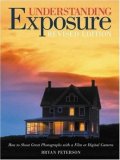 I haven’t quite kept to my resolution of reading one photography book a month, but I’m enjoying those books I have got through, including ‘Understanding Exposure
I haven’t quite kept to my resolution of reading one photography book a month, but I’m enjoying those books I have got through, including ‘Understanding Exposure‘ by Bryan Peterson .
It’s a quick read, with a few annoyances but a fair bit of good advice.
Aperture, shutter speed, ISO
At first sight, a book on getting the perfect exposure might seem slightly redundant in the days of RAW and after-the-fact exposure correction, but there are many benefits from getting it right the first time.
Firstly, you save processing time. Secondly, if you hit the sweet spot in the camera, you’ve got more creative leeway in either direction if you do want to do some adjustments later. And thirdly, don’t you just want to get it right?
Peterson’s assertion is that while there might be several correct exposures – different combinations of aperture, shutter speed and ISO that will deliver a passable result – there’s only one creatively right exposure for a given shot, and that’s what you should aspire to.
He argues that a wide-open aperture in low light might not be the best creative solution, but in the real world where we don’t carry tripods everywhere and children insist on moving, we might not get the luxury of choice.
Choosing what to meter
The strongest area of the book for me was information on how and what to meter in your images. if you’re shooting a classic landscape with fields and sky at sunset, for example, your camera might not do a great job of exposing either, given the high degree of contrast between the two.
So, you should choose whether you want to expose for the green fields to keep their texture, and risk blowing some of the detail out of the sky, or whether it’s the gorgeous red in the clouds you’re after (and you’re willing to put the fields in darkness to get it).
Then, with the camera in Aperture Priority mode and your chosen aperture selected to deliver the depth of field you’re after, fill the frame with the element you want (in this case, clouds or field), and half-depress the shutter. Note the shutter speed the camera suggests (assuming your selected ISO will let you handhold the camera if you’ve no tripod with you).
That’s the perfect exposure for the element in the frame you want to highlight. Then, switch to manual, set up the aperture and shutter speed to match the metering suggestion you just noted, and recompose your shot. Voilà.
Some cameras (possibly mine included – I need to RTFM again) offer an exposure lock feature where you can keep your exposure settings while recomposing the shot. That would make this a little easier, but as far as I can see, anything that gets me shooting fully manual is a good thing, so I don’t mind going the long way round on this if I’ve time.
Horses for courses
The book also does a good job of outlining the different lighting conditions you’ll come up against, and how to make the most of them. From solidly front lit – lots of contrast, not good for portraits – to subdued even light on cloudy days – lots of detail, good for architectural features – this analysis helps you identify what you’re dealing with on any particular occasion, and shows you what sort of shots work best.
There are lots of strong example photos throughout the book, with the technical information to show exactly the setup Peterson used. This helps to make the conceptual information real, as you can see the results of certain decisions.
Needs an edit
That said, some of the notes accompanying the photos become cringeworthy when the author delves into the personal. It’s interesting to know that a particular portrait was taken in Chinatown in Singapore, but things like ‘this is my beautiful wife cycling home. A great shot, and I didn’t need a release!’ get tired quickly.
So the tone wavers a little, which is a shame, as it could have been easily fixed with a more rigorous edit.
Conclusion
It’s a useful book that will improve your photography if you take its lessons to heart. You’ll run through it quickly, but the examples are impressive, and it makes you want to get out and try the techniques – always a good sign in a how-to book.